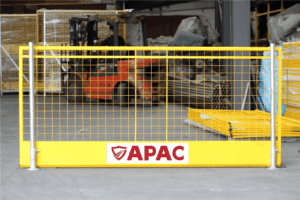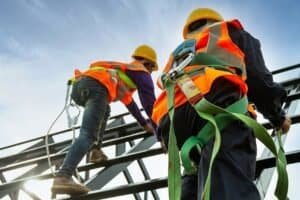Introduction
Temporary edge protection systems are utilized in work-at-height jobs and protect people from falling to lower surfaces. Edge protection systems are very new to the construction industry and other work-at-height jobs. Yet, you will see fast changes in its processing and popularity.
When you are specifying an edge protection system, standards and regulations can make it easier for you. However, there exist a large number of guidance documents, standards, and regulations. Such a huge variety may create a confusing situation for you. For example, you have to figure out which height regulations you really need to follow. It can be OHSA 1926.502, AS/NZS 4994.1, or EN 13374.

As a matter of fact, different countries own different regulations and standards for working at height. Therefore, you have to ensure that the edge protection system you are using matches your country’s regulations.
If you are wondering about how to choose an edge protection system according to your regulations. Or you want to know about standards and regulations of edge protection systems in different countries. This is the right place to check. This blog has everything that you need to know about standards of edge protection systems. Continue reading!
Standards in Different Countries
BRITAIN / EUROPE: BS EN 13374
As you know that safety is always a priority for people working on roofs/open edges. They should be protected from any exposed edges. Even those people who selected a temporary edge protection system must follow some rules to be on the safe side. Edge protection can be done in several ways. Moreover, it is to ensure the protection of workers in a strictly controlled environment.
BS EN 13374 is the British guidance system for edge protection systems that are implemented in the UK. You will see that this standard system classifies the edge protection systems into three classes. Each of these classifications is based on a particular loading situation. The BS EN 13374 is highly applicable where you need protection through edges.

BS EN 13374, the European standard is considered an adequate system to be used for edge protection. Here are three classes are given by BS EN 13374 to define edge protection:
- Class A
- Class is meant to be used at places where the angle is less than 10 degrees. The purpose of this class is to withstand the static load.
- It supports a worker that leans on the protection and provides holding when you walk beside it.
- It stops or prevents the workers from falling from heights.
- Class B
- This type of class is meant to be used for places where the angle is less than 30 degrees. In that case, there will be no limitation on falling height.
- Or it can be used for places where the angle must be less than 60 degrees but the height must be less than 2m.
- Note that the class B systems are assessed according to a low dynamic impact test.
- It is designed to withstand low dynamic forces and static loads:
- It provides a handhold when you walk beside it or provides support to the person that leans on the protection.
- It also tends to stop any work that can be falling towards the protection.
- Class C
- There are two conditions in class C protection systems.
- These are used where there is no limitation of height and the angle lies between 30 and 45.
- On the other hand, it can be used where the angle lies between 45 and 60 but the height is less than 5m.
- Note that these systems are assessed by high dynamic impact tests.
- It tends to stop the person that slides down a steeply sloping surface.
AUSTRALIA and New Zealand: AS/NZS 4994.1:2009
This standard was prepared by a committee, Joint Standards Australia/Standards New Zealand BD-092. It was meant to provide temporary edge protection for residential and housing buildings. It objects to giving guidance and requirements to equipment designers. Again, it also aims to prevent workers from falling from the edges of buildings.
- Note that BD-092 is an expansion of AS/NZS 4994.1(Int):2004. Whilst the 2004 edition did not specifically apply to roofs of commercial and industrial buildings the Scope noted that it could be used in the absence of a similar Standard.
- The standard works perfectly for places where the angle must not be greater than 35⁰.
- You cannot apply this standard to the containment of materials on residential roofs.
- It is used for buildings that are being renovated, Maintained, altered, extended, and constructed.
- It should be designed specifically for roofs where the angle exceeds 35⁰. In that case, you may have to use some other form of resistance to prevent risks.
- It specifies requirements for dismantling and installation of edge protection systems and those prior to the permanent Walling materials installation.
USA: OSHA 1926.502 (Occupational Safety and Health Administration)
OSHA standards are those standards that are actually implemented in the USA. According to these standards, your guardrails should reach a height of 42 inches. It can be +/- 3 above the walking-working surface. Moreover, it also ensures that the surface should withstand a weight of 200 pounds in an upward or downward direction.
- In any case, if your railing starts dipping below 39 inches due to the weight, then it will not comply with OSHA standards.
- It is recommended to contact an expert when following OSHA standards. He will guide you properly about what you may or may not need in edge protection.
- Note that OSHA standards don’t require the railing to be attached to the supporting structure.
Conclusion
You will see that most edge protection systems are following both the standards AS/NZS 4994 and BS EN 13374. Different manufacturers will provide you with several fixings to help you remove, reposition, or install in multiple ways. However, you have to ensure that whatever standards you are following, are allowed in your country.
If you are looking for a manufacturer to give you high-quality edge protection systems, complying with AS/NZS 4994.1 and BS EN 13374, Contact Us now. We are available 24/7 to help you.








